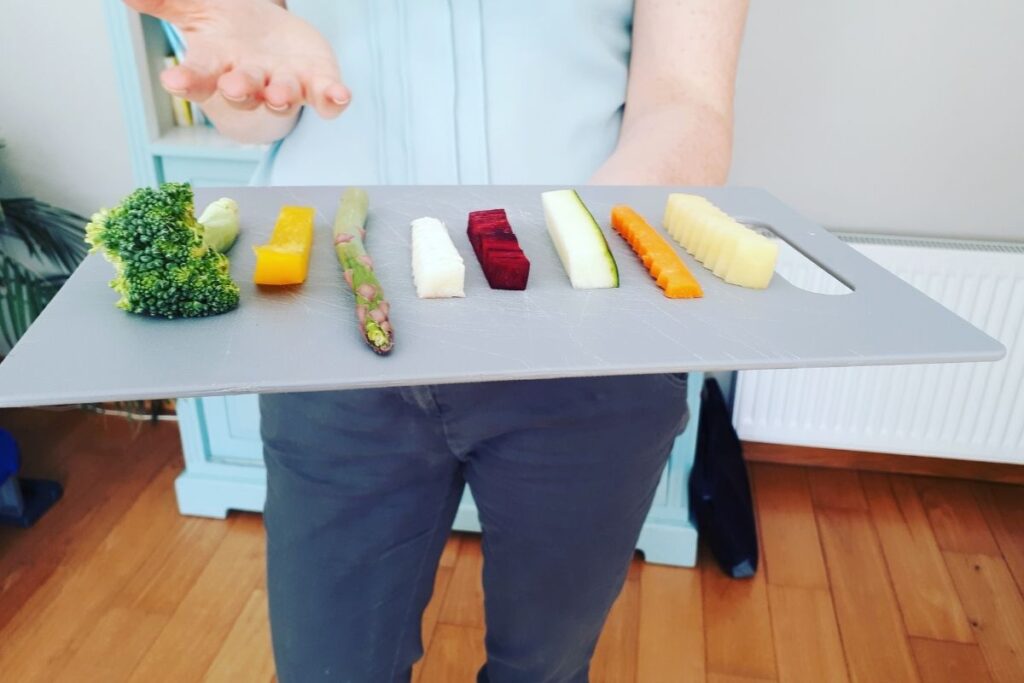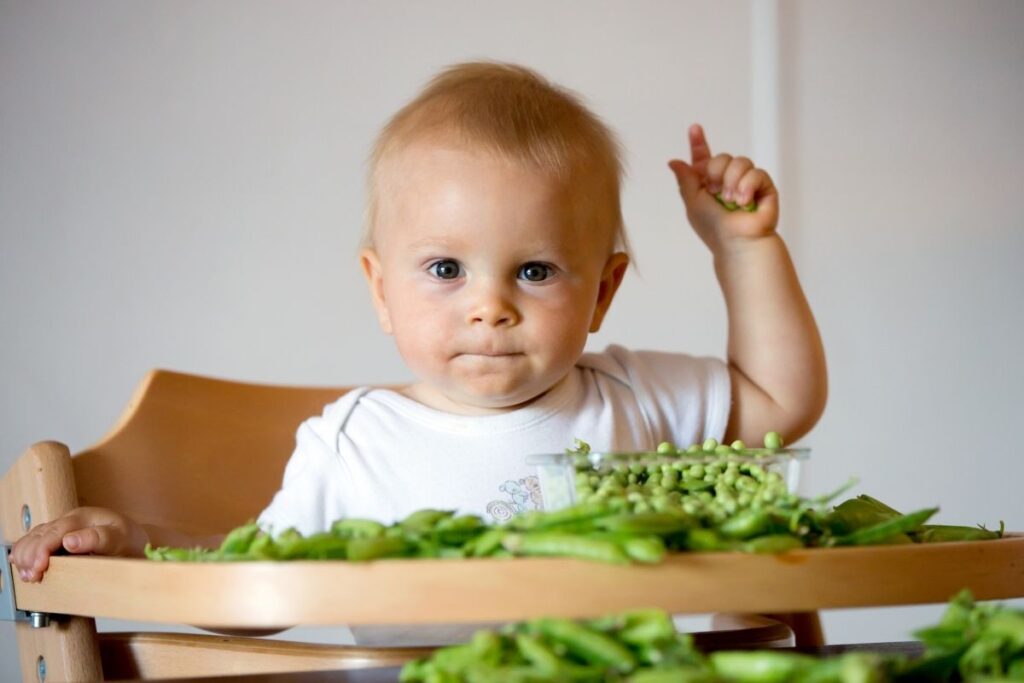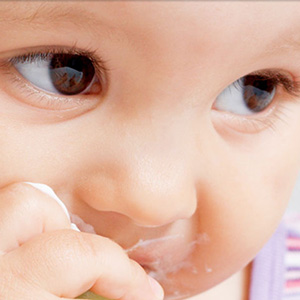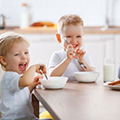Fear of choking is the number one fear expressed by parents during weaning. Learn how to maximise safety while reaping the benefits of baby-led weaning.
If you’re afraid of your baby choking, you’re not alone!
Choking is, without a doubt, the number one concern parents with me. It’s understandable to feel nervous about giving your milk-drinking baby a spear of broccoli; I felt the same way with my first baby. However, armed with the correct information, you can minimise the risk of choking whether you’re using a 100% baby-led weaning approach or offering some finger foods alongside spoon feeds.
Does Baby-Led Weaning Increase the Risk of Choking?
Research conducted in New Zealand showed that “Infants following a baby-led approach to feeding that includes advice on minimising choking risk do not appear more likely to choke than infants following more traditional feeding practices”. However, they also report that “many children in both groups offered foods that pose a choking risk is concerning”.
The key here is that parents were offered safety advice before starting weaning, which is, unfortunately, missing from much baby-led weaning (BLW) resources. Although not recommending BLW exactly, both the Irish and the UK weaning guidelines now recommend soft finger foods as being safe from 6 months alongside spoon-feeding.
The bottom line on the safety of baby-led weaning.
With the right precautions, BLW appears to be a safe way to introduce foods.

LEARN MORE >>> Baby-led weaning, spoonfeeding: The great debate.
Knowing the difference between Gagging and Choking
Before you start your baby on finger foods (or baby-led weaning), it’s essential to know the difference between gagging and choking.
“Loud and red, let them go ahead. Silent and blue, they need help from you.”
While gagging isn’t fun to watch or hear, rest assured that it’s nature’s way of protecting your baby’s airway. Gagging is very common in all babies, whether self-feeding or not. This is because your baby’s gag reflex is triggered farther forward on the tongue than in an adult. It moves back as your baby grows.
Even before introducing foods to your baby, help them control the gag reflex’s activation by encouraging them to ‘mouth’ toys with various textures. Only the back third of the tongue will stimulate a gag by about nine months, so gagging while eating will reduce. Choking, on the other hand, happens when food (or non-food items) obstruct the airway. Choking can be extremely dangerous.
Your baby is gagging when:
- Their eyes water
- Their face turns red.
- They make retching sounds.
- They may vomit
Don’t intervene!
Your baby is choking when:
- They’re staring open-mouthed.
- Their lips turn blue.
- They’re silent or making odd sounds.
- They’re gasping for breath.
- They’re waving their arms or clutching at their throat.
Perform First Aid
Solid Start Safety Checklist for baby-led weaning
Here’s what you need to know to keep your baby safe while offering the benefits of early self-feeding.
- Wait until your baby is six months of age and developmentally ready for solid foods.
- Know the difference between gagging and choking
- Test foods before you offer them to your baby to ensure they are soft enough to mash with the tongue on the roof of the mouth (or are large and fibrous enough that small pieces do not break off when sucked and chewed, e.g. strips of meat) especially in the early months
- Avoid offering foods that form a crumb in the mouth.
- Ensure that the foods offered are at least as long as the child’s fist, on at least one side of the food.
- Make sure your baby is always sitting upright when he or she is eating, never leaning backwards. Choosing the right highchair is vital.
- Never leave your baby alone with food; always have an adult looking at your baby when he or she is eating. Never sit your baby on your lap to eat, you won’t be able to see what’s happening.
- Never let anyone except your baby put food into her mouth; your baby must eat at her own pace and under her own control.
- Don’t offer toys or TV while eating. This isn’t a good habit anyway, but it’s better if your baby concentrates on eating without distractions.
- Take a Paediatric First Aid Course and watch these First Aid Videos from the NHS and St John’s Ambulance. Babies can potentially choke on any food, even those considered safe, so knowing what to do if the worst happens is vital.
LEARN MORE >>> Finger food ideas to get you started
Foods to avoid or modify when starting solids
| Food | Modify | |
| Apples
|
|
Peel, cut into wedges and steam, microwave or roast. Once your baby has developed their pincer grip at about eight months, you can grate and offer raw.
|
| Butter Beans, Kidney Beans and Chickpeas
|
Chickpeas: peel and cut in half
Kidney beans: squash or serve as a spread |
|
| Bread
|
Serve toast
|
|
| Celery
|
Avoid raw until 5+. You can cook until soft.
|
|
| Citrus Fruits
|
Peel each segment. Tinned mandarins are already peeled! Choose in juice rather than syrup.
|
|
| Corn
|
Cook until soft in a stew, offer corn on the cob or cut in half.
|
|
| Dried Fruit
|
Soak in boiling water and chop finely
|
|
| Fruit with stones and large seeds or pips (e.g., watermelon, small stone fruits)
|
Remove stones from fruits.
|
|
| Hard raw vegetables
|
Cook until squashable. Once your baby has a developed pincer grip, you can grate and serve raw.
|
|
| Leafy greens
|
Finely chop and cook until very soft.
|
|
| Nut butter
|
Spread thinly or mix into wet foods like yoghurt/cereal
|
|
| Nuts and seeds (pumpkin, sunflower)
|
As smooth butter or ground/milled
|
|
| Chunks of meat
|
Offer long strips before your baby has teeth so they can just suck. However, avoid ‘chunks’ of meat, slow cook to tenderise and then shred.
|
|
| Peas
|
Squash with a fork
|
|
| Pineapple
|
Slice thinly across the grain of fibres or serve in a mesh feeder
|
|
| Popcorn
|
Avoid until 5+
|
|
| Sausages and hot dogs or other foods cut into rounds or ‘coins.’
|
Don’t offer to under 1s due to salt content. After this, always but lengthways and to the size of your child’s pinkie nail.
|
|
| Sweets/Lollies/Marshmallows
|
Not recommended to babies anyway! Avoid until age 5+
|
|
| Whole grapes, cherries, cherry tomatoes, large blueberries, blackberries and raspberries
|
Slice lengthways into quarters—squash blueberries before serving.
Half raspberries and blackberries.
|
Get more expert advice on weaning your baby when you enrol in Ready, Steady, Wean. Suitable for parents with babies aged 4-10 months.
And why not subscribe to Solid Start and get tips on food, nutrition and feeding straight to your inbox every month?









0 Comments